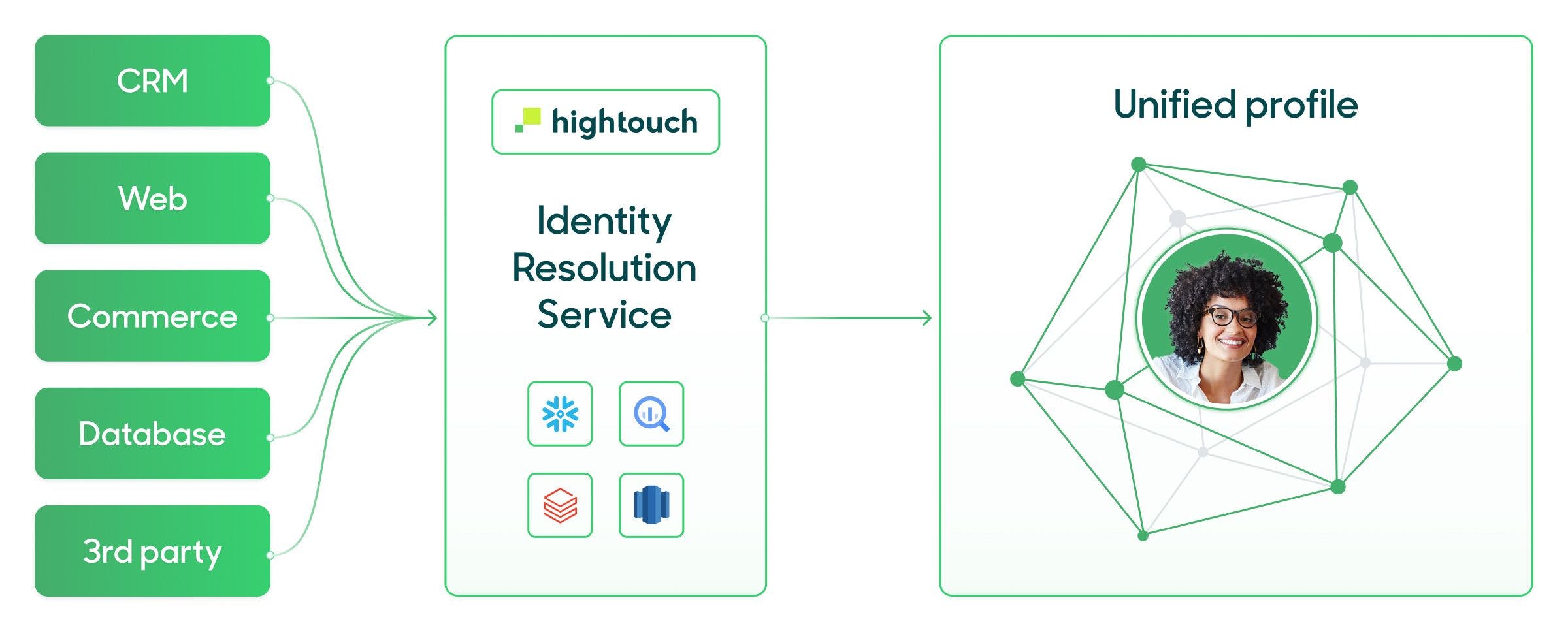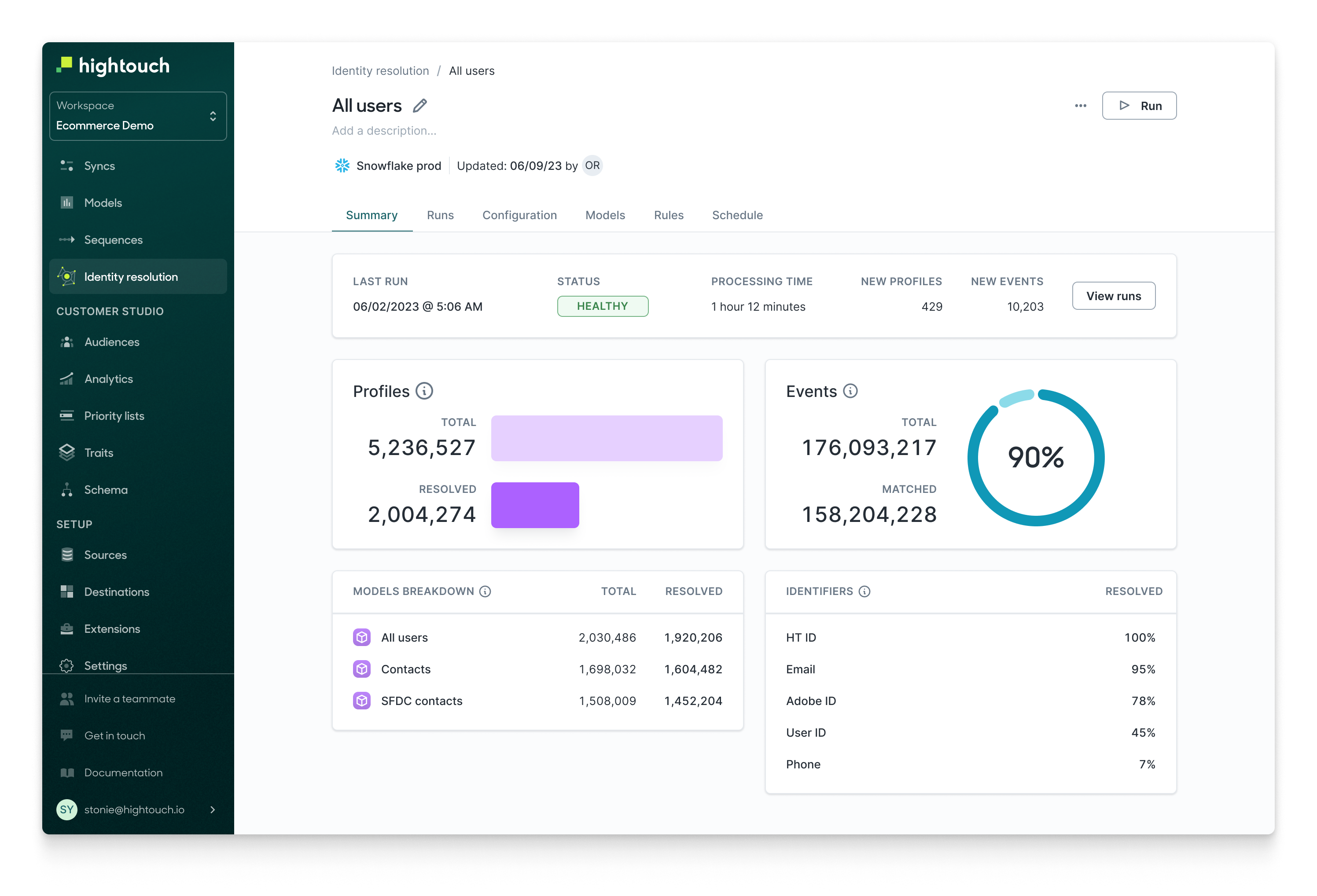Announcing Identity Resolution
The warehouse-native identity resolution feature that MarTech teams have been looking for.

John Tan
July 19, 2023
7 minutes
The work was cut out for us. How do we create an intuitive interface to express complex business logic that customers themselves can control? How do we let marketers achieve value out of the box, meanwhile scaling up for complex use cases? And most importantly, how do we do this directly within the data warehouse to provide the security and flexibility enterprises need?
Our approach: Configurability Without Complexity
As a pioneer of the “Composable CDP,” we started with the data warehouse – the ultimate source of truth for event streams, transactions, SaaS data, internal databases, and 3rd party data. By directly querying the data warehouse, Hightouch Identity Resolution builds on a much more complete set of customer data than just web and mobile events.
From there, we drew inspiration from typical data engineering workflows. A data pipeline can achieve high configurability without unnecessary complexity by composing together smaller pieces of business logic. Translation: marketers can get their complex needs satisfied without being blocked by limited data engineering resources.
In Hightouch’s Identity Resolution, many components can be combined to scale up to serve enterprise-grade business requirements. Concepts that can be composed include:
- Business rules – multiple resolution rules can be used, from attribution-esque rules to resolve anonymous events to fuzzy algorithms for offline demographic data.
- Data cleaning – a growing library of preprocessing tools, like aliasing names, standardizing address conventions, or normalizing phone numbers.
- Identity graphs – different existing identity graphs – even from other tools – can be used as inputs for Hightouch Identity Resolution.
Underneath the hood, Hightouch Identity Resolution generates custom SQL for this identity pipeline. The code implements optimizations. These include recursion, incrementality, and smart partitioning. We handle the nitty-gritty work so that your data engineering team doesn’t have to spend months on it.
Ultimately, each marketer’s identity resolution use case is unique. The needs differ even between teams in the same company, such as paid media, lifecycle marketing, and customer operations. Hightouch’s approach results in an identity resolution process that can be quickly configured and customized without code.

How Hightouch Identity Resolution Works
The new Identity Resolution feature enables organizations to define logic to create unified customer profiles and associate events with those profiles using a powerful no-code UI. Hightouch writes an identity graph directly into a table in the organization’s data warehouse, which is then available to power downstream use cases. Organizations can set recurring schedules for when Hightouch updates their identity resolution models and monitor performance and outcomes at a glance.

Data Onboarding: Organizations can access different profile and event tables directly from their data warehouse in Hightouch and define key identifiers from within each table. Hightouch also enables teams to define custom models in their data warehouse with SQL or dbt. Whatever data exists in the warehouse is available for identity resolution.
Similarly, profiles are not limited to individual customer identity records. The Customer 360 Toolkit also enables entity resolution. Companies can use this product to unify profiles for any other entity record type, such as households or accounts.

Merge records when: logic to describe when two records may belong together. For example, users can merge two records when email is an exact match OR ‘full name is an exact match after aliasing AND zip code is a fuzzy match.’

Pause merging if: rules to pause merging if a single profile exceeds predefined limits. This prevents erroneous merges from occurring. For example, if a profile has more than ten emails, then pause the proposed merge.

Resolve conflicts by: methods for resolving conflicts if a merge is paused. For example, we can default to the earliest created profile or retry the merge with a strict priority of identifiers. We support a growing library of modules – by stacking different ways to resolve conflicts, users can express powerful custom logic in a way that’s easy to understand.
Output: Finally, Hightouch writes the results of this unification – an identity graph – directly to a table within the data warehouse. Companies can leverage these lookup tables directly in Hightouch or for analytics, measurement, or other operational use cases. Since these tables are in the warehouse, users have full access and control to determine how to use the output of Identity Resolution.
Getting Started
Interested in solving identity resolution, building customer profiles in your data warehouse, and activating your data to 200+ downstream destinations? Book a demo today to speak to our solutions engineers. We’re here to help you make the most of your data warehouse and put your customer data to work.



